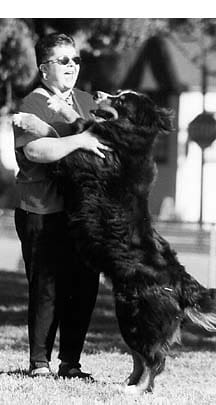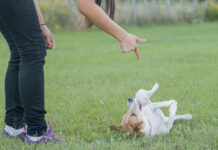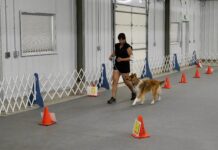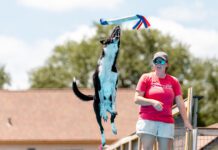[Updated February 6, 2019]
I used to show my dogs in competitive obedience. In the beginning, the opportunity to earn obedience titles and show off my dog’s training appealed to me greatly. But as I evolved toward positive training methods and a more fulfilling relationship with my dogs, the military precision of the show ring lost its charm. I realized that it made no sense to have a relationship with my canine pals based on warm interaction and communication outside the ring, only to march in cold silence next to my dogs inside the ring. I stopped showing and turned my efforts toward family dog training and activities that were more fun and flexible, like agility and canine freestyle.
I’m not alone; lots of people have dropped out of competitive obedience events for similar reasons. But finally someone has done something to bring me and those like me back into the ring.
A Need for Competitive Obedience
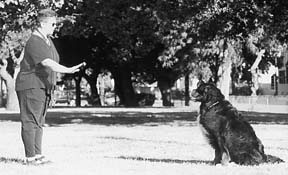
Charles (Bud) Kramer is a long-time dog sport enthusiast who was instrumental in the introduction and promotion of canine agility in this country in the early 1980s. On December 5, 1998, he was munching a sandwich in his Kansas State University office while reading a dog magazine. The author of the article was fussing about the fact that fewer new dog owners interested in performance activities were pursuing competitive obedience. Traditional obedience was failing to win new followers because dog owners were increasingly drawn to other canine sports.
As Kramer thought about (and agreed with) the article, he speculated that the rigid format of competitive obedience was largely responsible for the decline in participation.
Rather than dismissing the issue, he did something about it! He invented Rally Style Obedience, a canine sport so new that there haven’t even been any official competitions yet. But there will be soon. Kramer has been in negotiations with the American Kennel Club, and it is anticipated that this sport will be available as an AKC non-regular class at dog shows in the fall of this year. While the AKC events will be restricted to purebred dogs only, there is nothing to prevent 4-H groups, mixed breed dog clubs, humane societies and other organizations from offering Rally Obedience competitions for all dogs. Want to get in on the ground floor of this exciting new activity? Read on.
Rally Excitement
Rally Style Obedience was created to provide a forum for obedience training that emphasizes fun and excitement for the dog, handler and spectator, by allowing for a more natural approach to the performance. Most of us talk to our dogs when we train. We work as partners, as a team. We praise and reward our dogs when they do well, and encourage them when they are unsure of themselves. The competition format for Rally Obedience closely mimics the real human/canine relationship by allowing natural interaction between handler and dog even in the ring.
“It was pretty simple,” says Kramer. “It took 10 minutes to come up with the idea, and another 18 months to put it all together. I just took all of the elements that make agility so popular – the fact that you can talk to your dog; that it’s fast moving and done on a continuous course without pauses for judges’ instructions and scoring; and that the course is variable, with different course outlines and variations in exercises. By the time I finished my sandwich the concept had gelled.”
The name “Rally” comes from the use of directional signs rather than a judge’s commands to prompt the handler/dog team to perform the next exercise, similar to the popular sport of Road Rally for cars.
The course designer selects from 45 different approved Rally exercises and creates a course using 25 to 28 of them. For readers familiar with equestrian sports, this is something like a Grand Prix jumper course. Like riders of Grand Prix jumpers, Rally handlers have the opportunity to walk the course before the class starts, to plan their strategy.
Seven of the Rally exercises may be used more than once in any given course, the rest cannot be repeated. Each directional sign gives instructions for that exercise, and when handler and dog have completed the exercise they move on to the next station.
For example:
• Sign #1: Fast Pace (dog and handle move at a faster-than-normal pace to the next sign)
• Sign #2: Slow Pace (dog and handler drop to a slower-than-normal pace and continue to the next sign)
• Sign #3: Normal Pace (dog and handler proceed to the next sign at a normal pace)
• Sign #4: About Turn Right (dog and handler make a 180 degree turn to the right and proceed back in the direction from which they just came)
• Sign #5: Right Turn (dog and handler make a 90 degree turn to the right)
• Sign #6: Spiral Left, Dog Inside (dog and handler make an increasingly large spiral around four orange cones, with the dog on the inside of the spiral) . . . and so on, until the course is completed.
There are two levels of performance. Level One (entry level) is done on leash. Level Two is off-leash, with more challenging exercises included on the course. Both levels are made up of exercises similar to those found in the Novice level of obedience competition. Kramer anticipates that down the road there may be additional levels that incorporate more advanced exercises from Open and Utility obedience classes.
Judging the Rally Course
Like competition obedience, the dog and handler team enters the Rally course with a perfect score of 200, and points are deducted as either member of the team makes mistakes. However, the similarity ends there.
The Rally handler may repeat verbal and hand signal cues without penalty, and may follow a cue with praise or encouragement. (In the obedience ring this would constitute a significant penalty.) The handler may continue to encourage and praise the dog throughout each exercise, and while the exercise must be performed satisfactorily, the dog’s attitude, attention and response are considered more important in scoring than is exact precision. Ongoing verbal reassurance is also allowed to help prevent a dog from making an error, for example, during the heeling and stay exercises.
The judge follows the dog and handler around the course, marking point deductions for minor to major errors. In order to earn a qualifying score, the team must receive at least 170 points and successfully complete each of the exercises on the course. Point deductions of one-half to three points are subtracted for most errors. If more than five points total are subtracted for any particular exercise, the team does not qualify. Major errors that would result in an automatic non-qualifying score include:
• Failure of the dog to remain in position on a stay exercise
• Failure of the dog to come when called in the recall and “front” exercises
• Knocking over a cone or being on the wrong side of a cone in the spiral and figure-8 exercises
• Failure of the dog to jump over the jumps during the jumping exercises
• Heeling performance in between exercises is also judged, but of course, talking and praise are allowed here too.
Can’t you just imagine it? You’re smiling, laughing, talking to your dog in the show ring, in an excited, happy voice, praising her for doing well. She prances by your side, eyes bright, tail wagging. You and your dog are winning titles and ribbons, and having fun doing it naturally; showing the whole world that the two of you enjoy being together, working, playing, communicating as friends and partners. What a concept!
Pat Miller, CBCC-KA, CPDT-KA, is a freelance author and a professional dog trainer in Fairplay, Maryland.


